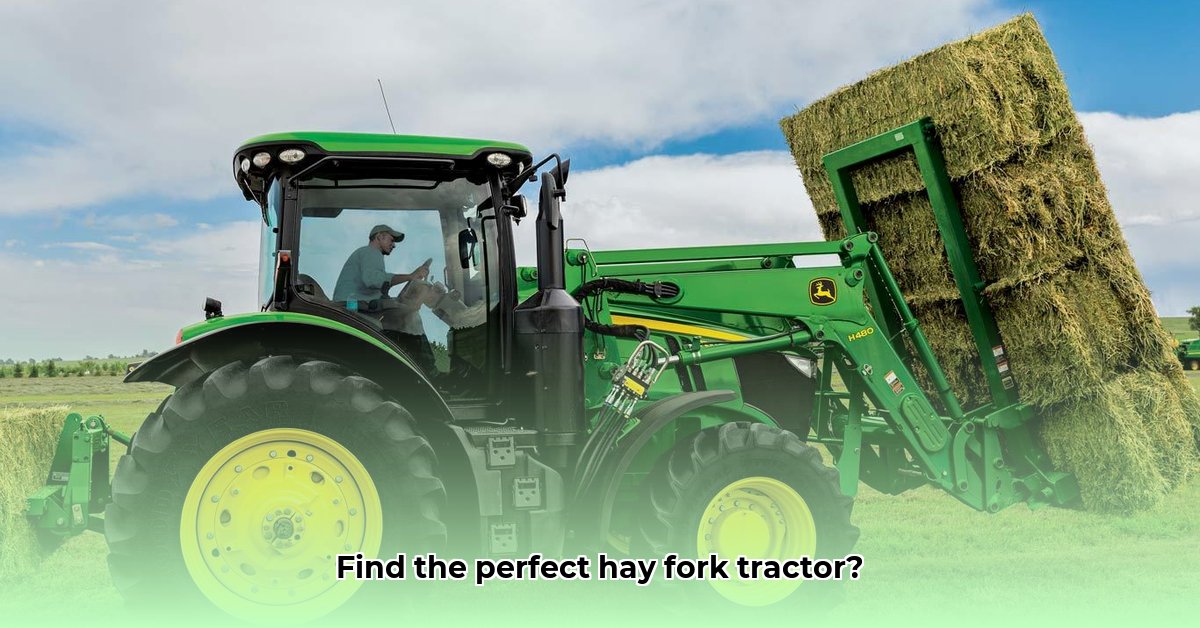
Choosing the right hay fork tractor significantly affects your farm's efficiency and sustainability. This guide helps you compare models based on key factors like bale handling, durability, and fuel consumption. We'll cover everything from assessing your needs to selecting a model and maintaining it for long-term performance. For more on tractor implements, see this helpful guide: Tractor Implements Guide.
Assessing Your Needs: Bale Size, Volume, and Field Conditions
Before diving into specific models, honestly assess your farm's needs. What size bales do you handle (small square, large round, or both)? How many bales do you move daily or seasonally? These factors directly influence the required lifting capacity and overall durability of your hay fork tractor. Large-scale operations will need a heavy-duty system, while smaller farms might find a lighter-duty model sufficient. Also consider field conditions. Narrow rows require maneuverability, impacting tractor size and turning radius.
Key Features of a High-Performing Hay Fork Tractor
Several critical features impact a hay fork tractor's performance and longevity. Consider these when comparing models:
- Lifting Capacity: This must match your heaviest bale loads, with a safety margin built in. Underestimating this can lead to equipment failure and potential accidents.
- Reach and Lift Height: Ensure the tractor easily lifts and places bales into storage. Measure your storage building heights carefully. Insufficient reach can limit efficiency and cause strain on operators.
- Durability and Build Quality: High-strength steel construction with reinforced components reduces the likelihood of damage and extends the equipment's lifespan. Look for robust designs in areas subject to high stress.
- Ease of Use and Operator Comfort: Simple, intuitive hydraulic controls and ergonomic design minimize operator fatigue and increase efficiency. Safety features are paramount; prioritize models with well-designed safety systems.
- Maintenance and Parts Availability: Easy-to-service designs and readily available parts minimize downtime and repair costs. Consider the manufacturer's reputation for parts availability and service support. This is very important for preventing long-term disruption.
Comparing Hay Fork Tractor Models: A Step-by-Step Process
Comparing models effectively requires a systematic approach:
Gather Information: Collect brochures or specifications from several manufacturers. Pay close attention to lifting capacity, reach, height, and tractor weight. Don't hesitate to contact manufacturers directly with specific questions.
Compare Features: Evaluate ease of operation, safety features, and maintenance requirements. Factor in warranty length; a longer warranty suggests greater confidence in durability.
Read Reviews: Consult online reviews from other farmers. Real-world experiences often highlight a tractor's strengths and weaknesses. Look for consistent feedback across multiple sources.
Analyze Total Cost of Ownership: Consider the purchase price, expected maintenance costs (parts and labor), and fuel efficiency. Some tractors may offer substantial long-term savings through reduced fuel consumption. Fuel efficiency alone can significantly impact the total cost of ownership over the tractor's operational lifespan.
Sustainable Hay Handling: Beyond Equipment Selection
Sustainable hay handling encompasses your entire process. Consider these elements:
Smart Bale Placement: Organized stacking prevents waste and reduces the risk of bale damage. This might involve designing your storage system for optimal bale placement and organization. Efficient stacking can lower waste and save labor costs.
Fuel Efficiency: Practice efficient driving habits (avoid idling, smooth acceleration and braking) to reduce fuel consumption and environmental impact. Consider the fuel efficiency specifications of different tractor models. Lower fuel consumption directly translates into cost savings and a reduced carbon footprint.
Hay Storage: Protect your hay from the elements to maintain quality and reduce spoilage. Proper storage minimizes waste and protects the nutritional value of your hay.
Hay Fork Tractor Checklist: Summarizing Key Considerations
| Feature | Key Considerations | Impact on Sustainability |
|---|---|---|
| Bale Type | Small square, large round, or both? | Determines required fork design and capacity |
| Lifting Capacity | Match your heaviest bales; add a safety margin | Prevents equipment failure and potential accidents |
| Reach & Height | Sufficient reach for storage and field conditions | Optimizes efficiency and reduces operator strain |
| Durability | High-strength steel, reinforced components | Reduces repair costs and extends equipment lifespan |
| Ease of Use | Simple controls, safety features, ergonomic design | Enhances efficiency and operator safety |
| Maintenance | Easy access to parts, readily available service | Minimizes downtime and lowers overall maintenance costs |
Remember, choosing the right hay fork tractor is a significant investment. Thorough planning, careful consideration of your specific needs, and a systematic comparison of available models will ensure a purchase that maximizes efficiency, boosts profitability, and promotes environmental sustainability. Dr. Anya Petrova, Agricultural Engineer at the University of California, Davis, emphasizes that "investing in durable, efficient hay handling equipment is vital for modern farmers to achieve long-term economic and environmental sustainability."